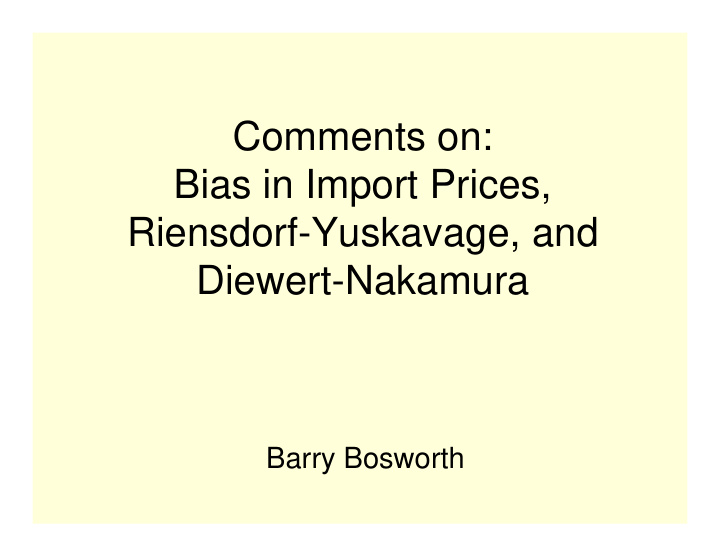



Comments on: Bias in Import Prices, Riensdorf-Yuskavage, and Diewert-Nakamura Barry Bosworth
Basic Problem • Large increases in import share of intermediate inputs are presumed to create a upward bias in the overall price indexes for intermediate inputs, and hence an underestimate of their real contribution to output. – The substitution of a foreign for a domestic supplier is treated as the introduction of a new good and the price change between the two goods is linked out of the aggregate price index – replaced with a zero – Very analogous to outlet substitution bias
Basic Problem 20 15 domestic price foreign 10 linked out 5 1 2 3 4 5 6 7 8 period
Basic Problem • To the extent that the domestic and foreign products are identical, would like to include the price difference (presumed negative) – Example of branded versus generic products – Differences in distance and borders suggest that they are not exactly equivalent – From buyer’s perspective, correct answer is somewhere in between.
Two papers • Magnitude of growth in imported intermediate inputs suggest that bias could be large. • Compounded by shifts in real exchange rates • Riensdorf &Yuskavage focus on measuring the size of the bias by using CPIs as a proxy for a buyer’s index. • Diewert & Nakamura explore methods of identifying and adjusting for the bias.
Measuring the Price Differential • Ideally, we could collect price data from buyers rather than sellers – Same product purchased from supplier A in period 1 and supplier B in period 2. – Change in source of supply would not trigger a change in the product characteristic and price change would not be linked out. – Buyer price index should rise more slowly than import price index.
Riensdorf & Yuskavage • Riensdorf and Yuskavage use the CPI as a substitute for the buyer’s price. • Limit analysis to comparable product groups and include estimate of distribution costs and commodity taxes. • Four price indexes – CPI – Producer price (include distribution costs) – Supplier price (domestic &import) – Import price • Similar idea to that of Greenlees & McClelland for outlet bias
Riensdorf & Yuskavage • Indications of significant bias for electronics and apparel • Matches are quit good for other nondurables and motor vehicles • I am puzzled by wide variation in distribution margins. Don’t completely understand the methodology.
Riensdorf & Yuskavage • I found the results to be supportive of the view that the substitution bias for import prices is likely to be substantial – a problem for estimates of productivity growth, particularly in manufacturing. • Implications for measuring productivity of big- box distributors that buy directly from overseas? • Are the methodologies for electronics comparable in the CPI, PPI, and import price index? • Further evidence of need to develop alternatives to simply linking out price differences
Diewert & Nakamura • Conceptual paper showing how the substitution bias of outsourcing can be represented within a price index and a potential framework for measurement. – General problem results from outsourcing and growth of contract manufacturing, but it may exacerbated by cross-border imports and offshoring. • Paper includes a useful summary of the construction of the major price indexes and integrated industry accounts.
Two Measurement Biases in IPP • Substitution bias – Similarity to outlet substitution bias in CPI – Imparts upward bias to price index • Product replacement bias – Seems equivalent to new model problems for CPI – Association between introduction of new model and price adjustments – Price change gets linked out – Bias could be positive or negative • Focus of paper is on substitution bias
Diewert & Nakamura • Conceptual Framework with emphasis on four sectors that sharply distinguishes between suppliers and purchases. – Helps to make clear the distinction between a supplier price index and a buyer price index – If we had the price levels data for both the new and the old suppliers in both periods, it would be easy to incorporate the price difference between the old and new supplier. – The authors provide the formulas to compute the correct index for all four sectors if all the data were available. – Information for sector 3 is unlikely to be obtainable in real world.
Diewert & Nakamura • Conceptually there is nothing special about outsourcing, but it does increase the difficulty of obtaining the data for the ideal index that they outline. • Paper highlights the challenge and clarifies the sources of the bias, but • The authors do no provide a solution for the real world.
Diewert & Nakamura • The firms required for the adjustment are not in a common database. • Price index data are obtained from supplier firms • Their example needs buying and selling firms • Only the buyer firm knows difference between old and new input costs
What to do? • We learn that it is a significant problem • Diewert & Nakamura provide clear example of required information • Buyer survey? • Approximation formula? – view problem as too many zeros– linked out changes- - in a supplier price index based on combining domestic and foreign inputs. – Compute distribution of price differences in a sub- sample and apply more broadly.
Recommend
More recommend